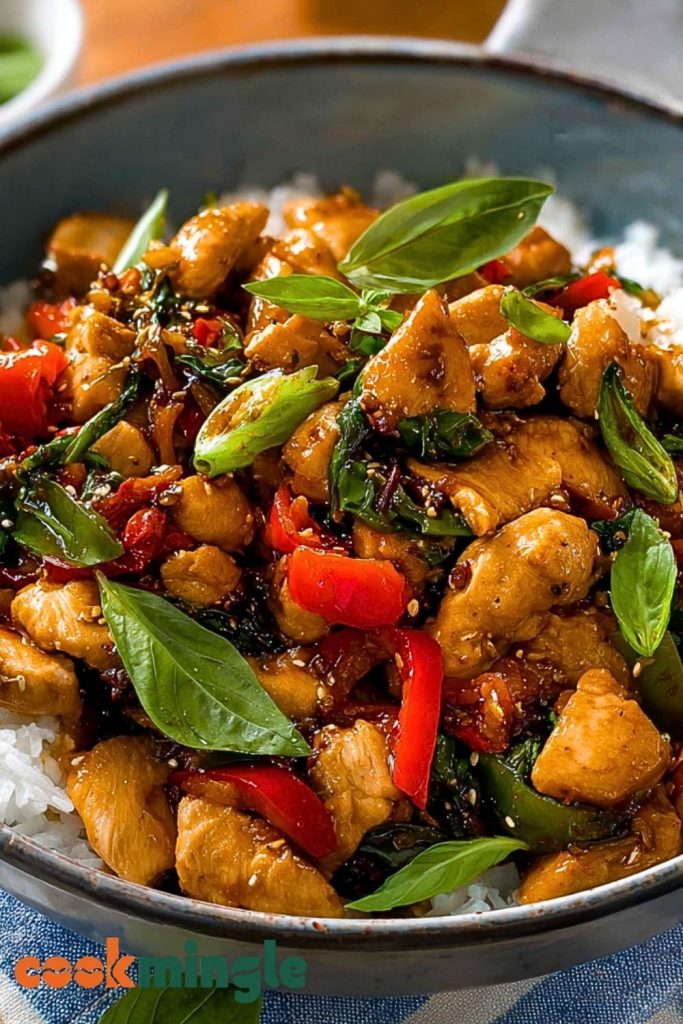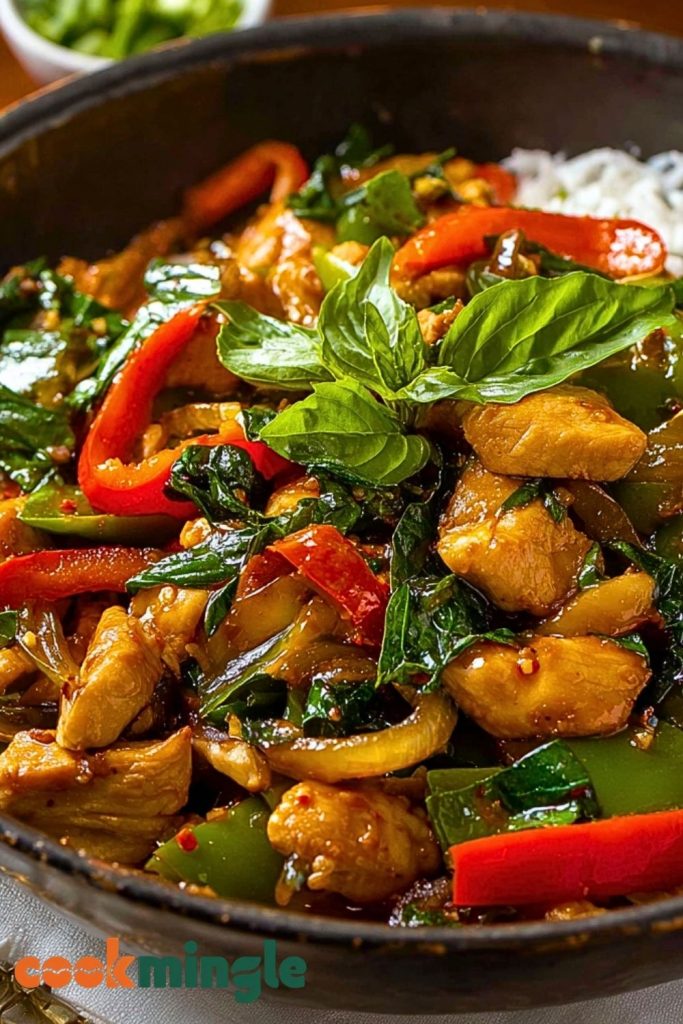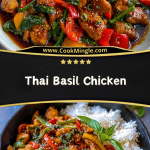Bold, aromatic, and bursting with flavor, Thai Basil Chicken (known as Pad Krapow Gai in Thailand) is a stir-fry favorite that delivers spicy, savory, and slightly sweet notes in every bite. This vibrant dish features tender chicken pieces stir-fried with colorful bell peppers, fresh garlic, Thai chilies, and a generous handful of Thai basil leaves. The sauce clings beautifully to each piece of chicken, creating a glossy, umami-rich glaze that’s downright irresistible.

Often served over steaming white rice, Thai Basil Chicken makes for a quick, restaurant-style dinner that comes together in under 30 minutes. It’s the kind of dish that satisfies both a weeknight craving and a special gathering. The contrast of heat from the chilies, crunch from the vegetables, and the peppery punch from Thai basil leaves sets this dish apart from other stir-fries.
Why You’ll Love This Thai Basil Chicken
- Quick and Easy: A full meal ready in under 30 minutes—perfect for busy weeknights.
- Flavor Explosion: Balanced with spicy, sweet, savory, and fresh basil tones.
- Customizable: Easily adjust spice level or swap in your favorite vegetables.
- Restaurant-Quality at Home: Authentic taste with simple, fresh ingredients.
- Low Effort, High Reward: Minimal prep work, maximum satisfaction.
Preparation Phase & Tools to Use (Essential Tools and Equipment, and the Importance of Each Tool)
Before diving into cooking your Thai Basil Chicken, getting organized makes the entire process seamless and enjoyable. Here’s what you’ll need and why each item matters:
- Wok or Large Skillet: A wok is ideal for high-heat, quick stir-frying. It distributes heat evenly and gives you enough surface area to toss ingredients properly. If you don’t have a wok, a large non-stick skillet works just as well.
- Sharp Chef’s Knife: Prepping the chicken and vegetables efficiently depends on a good, sharp knife. Clean cuts ensure even cooking and better texture.
- Cutting Board: Use one for meat and another for vegetables to avoid cross-contamination.
- Mixing Bowls: Helpful for marinating chicken and organizing chopped veggies before stir-frying.
- Tongs or Spatula: For tossing and turning ingredients quickly while maintaining their shape.
- Measuring Spoons & Cups: Essential for getting the sauce ratios just right—Thai food is all about balance.
- Rice Cooker or Saucepan: Perfectly steamed jasmine rice is the traditional sidekick to this dish, and having it ready at the same time is key.
Preparation Tips
- Slice Chicken Evenly: Cutting the chicken into uniform bite-sized pieces helps it cook quickly and evenly in the hot wok.
- Prep Everything First: This stir-fry comes together fast, so have your ingredients chopped and ready to go before turning on the heat.
- Use Fresh Thai Basil: Sweet basil won’t deliver the same peppery, slightly spicy flavor. Thai basil has purple stems and a distinct anise-like aroma.
- Control the Heat: Adjust the number of Thai chilies based on your spice tolerance. Removing the seeds can also reduce heat.
- Don’t Overcrowd the Pan: Cook in batches if needed. Crowding will steam your ingredients instead of stir-frying them.
- High Heat is Key: The sear from high heat adds depth and texture. Make sure your pan is hot before the chicken hits it.
Ingredients for This Thai Basil Chicken
Here’s everything you’ll need to bring this flavorful stir-fry to life:
For the Chicken:
- 1 lb (450g) boneless, skinless chicken thighs or breasts, cut into bite-sized pieces
- 1 tablespoon soy sauce (for marinating)
- 1 teaspoon cornstarch (optional – for tenderness and sauce cling)
For the Stir-Fry:
- 2 tablespoons vegetable oil
- 4 cloves garlic, finely minced
- 2–3 Thai red chilies, thinly sliced (adjust to taste)
- 1 red bell pepper, chopped
- 1 yellow bell pepper, chopped
- 1/2 cup green onions, sliced diagonally
- 1 cup Thai basil leaves (fresh, not dried)
- 1 tablespoon sesame seeds (optional for garnish)
For the Sauce:
- 2 tablespoons soy sauce
- 1 tablespoon oyster sauce
- 1 tablespoon fish sauce
- 2 teaspoons brown sugar
- 1 tablespoon water (to loosen the sauce if needed)
To Serve:
- Steamed jasmine rice or sticky rice
This combination creates a perfectly balanced dish—salty, spicy, aromatic, and just a touch sweet.

Step 1: Marinate the Chicken
In a medium bowl, combine the chicken pieces with 1 tablespoon of soy sauce and 1 teaspoon of cornstarch (if using). Mix well and let it sit for 10–15 minutes while you prep the other ingredients. This step helps tenderize the meat and ensures better flavor absorption.
Step 2: Prepare the Sauce
In a small bowl, whisk together the soy sauce, oyster sauce, fish sauce, brown sugar, and 1 tablespoon of water. Set this aside—having it ready means you won’t need to measure mid-stir-fry.
Step 3: Heat the Pan
Place a wok or large skillet over medium-high heat. Once hot, add the vegetable oil. Swirl it around to coat the surface.
Step 4: Sauté Aromatics
Add the minced garlic and sliced Thai chilies to the hot oil. Stir quickly for 30 seconds, until fragrant but not burned.
Step 5: Cook the Chicken
Toss in the marinated chicken pieces. Stir-fry for 4–6 minutes, turning occasionally until fully cooked and slightly golden around the edges.
Step 6: Add Vegetables
Add the chopped bell peppers and green onions. Stir-fry for another 2–3 minutes, just until they’re slightly softened but still crisp.
Step 7: Pour in the Sauce
Give your prepared sauce a quick stir, then pour it into the pan. Toss everything to coat evenly. Let it simmer for 1–2 minutes so the sauce slightly thickens and glazes the chicken.
Step 8: Add Thai Basil
Turn off the heat and immediately stir in the Thai basil leaves. They’ll wilt quickly in the residual heat, releasing their incredible aroma.
Step 9: Serve
Spoon the hot Thai Basil Chicken over a bed of steamed jasmine rice. Sprinkle with sesame seeds if desired, and serve immediately while fresh and hot.
Notes
- Protein Variations: You can substitute chicken with ground chicken, tofu, shrimp, or even thinly sliced beef—just adjust the cooking time accordingly.
- Control the Spice: Thai basil chicken is traditionally spicy, but if you’re sensitive to heat, use fewer chilies or swap in milder ones like Fresno peppers.
- Vegan Adaptation: Swap the chicken for tofu or mushrooms, and use soy sauce in place of fish and oyster sauces—look for mushroom-based alternatives for umami.
Watch Out for These Mistakes While Cooking
- Skipping the Basil: Regular basil is not the same as Thai basil. If you can’t find Thai basil, wait until you can—its unique flavor makes the dish.
- Overcrowding the Pan: This will steam the ingredients and make them soggy instead of giving you that stir-fried sear and flavor. Use a large pan or cook in batches.
- Cooking on Low Heat: Thai stir-fries rely on high heat to lock in flavor fast. A lukewarm pan will result in bland, limp chicken.
- Adding Basil Too Early: Basil should go in at the end—just after turning off the heat. If added too soon, it turns black and loses its aromatic punch.
- Too Much Sauce: A little goes a long way. The goal is to coat the chicken, not drown it. Excess sauce can make the dish salty or overly sweet.
- Using Wet Chicken: Pat your chicken dry before marinating. Moisture will cause it to steam rather than sear.
- Not Tasting the Sauce: Always taste your sauce before pouring it in—you might want more sweetness, heat, or salt depending on your preference.
- Overcooking the Garlic: Garlic burns quickly. Sauté it just until golden and fragrant before adding the chicken to avoid bitterness.
What to Serve With Thai Basil Chicken?
While Thai Basil Chicken is a complete dish on its own, pairing it with the right sides or accompaniments can elevate your meal even further. Here are some fantastic choices to round out your dinner.
8 Recommendations
1. Steamed Jasmine Rice
The traditional base—its soft, aromatic grains soak up the flavorful sauce perfectly.
2. Fried Egg (Kai Dao)
Crispy on the edges with a runny yolk, a Thai-style fried egg on top adds richness and texture.
3. Cucumber Salad
Cool and refreshing, a light cucumber salad with vinegar, sugar, and chili helps cut through the heat.
4. Spring Rolls
Whether fresh or fried, spring rolls bring crunch and freshness to the meal.
5. Thai Iced Tea
The creamy sweetness of Thai iced tea balances the dish’s spicy notes beautifully.
6. Papaya Salad (Som Tum)
This tangy, spicy salad makes a zesty contrast to the savory basil chicken.
7. Sticky Rice
Especially popular in Northern Thailand, sticky rice is great for soaking up the sauce.
8. Stir-Fried Morning Glory (Pad Pak Boong)
A garlicky, soy-based veggie side that keeps the Thai theme going strong.
Storage Instructions
Refrigeration:
Allow leftovers to cool completely before transferring them into an airtight container. Store in the refrigerator for up to 3 days. Reheat in a skillet or microwave until warmed through. Add a splash of water if the sauce has thickened too much during storage.
Freezing:
You can freeze Thai Basil Chicken, though the basil may lose some of its aroma. Freeze in freezer-safe containers or bags for up to 2 months. Thaw in the refrigerator overnight before reheating.
Reheating Tip:
Use a nonstick pan over medium heat with a tablespoon of water to revive the sauce while preserving the texture of the chicken and veggies.
Estimated Nutrition (Per Serving, without rice)
- Calories: 310
- Protein: 28g
- Fat: 18g
- Saturated Fat: 3.5g
- Unsaturated Fat: 13g
- Trans Fat: 0g
- Carbohydrates: 10g
- Fiber: 1g
- Sugar: 5g
- Sodium: 850mg
- Cholesterol: 85mg
- Serving Size: About 1 cup
- Category: Main Course
- Cuisine: Thai
- Method: Stir-Fry
- Diet: Gluten-free adaptable (use GF soy/fish sauce)
Frequently Asked Questions
1. Can I use regular basil instead of Thai basil?
You can, but it won’t have the same flavor. Thai basil has a spicy, anise-like taste that’s essential to the dish. Regular sweet basil is milder and lacks the same aromatic punch.
2. Is Thai Basil Chicken very spicy?
Traditionally, yes—it uses Thai chilies. But you can control the heat by reducing the number of chilies or removing the seeds. You can also substitute with milder peppers if needed.
3. Can I make this with ground chicken?
Absolutely! Ground chicken is a common alternative and cooks even faster. It also soaks up the sauce nicely, giving you a slightly different but equally delicious texture.
4. What kind of rice should I serve it with?
Jasmine rice is the most traditional pairing. Its fragrant aroma and soft texture make it perfect for absorbing the sauce. Sticky rice is also a great option.
5. Can I meal prep this recipe?
Yes! Thai Basil Chicken keeps well for a few days and is great for meal prep. Just store it separately from the rice and reheat together when ready to eat.
6. What vegetables can I add or substitute?
Feel free to add snap peas, broccoli, baby corn, or carrots. Just make sure they’re chopped small and cooked quickly to keep that crisp stir-fry texture.
7. Is this recipe gluten-free?
It can be! Simply use gluten-free soy sauce and a gluten-free alternative to oyster and fish sauces. Double-check the labels for any hidden gluten.
8. How do I make the sauce thicker?
If you want a thicker glaze, add 1/2 teaspoon of cornstarch to your sauce before cooking. It will thicken as it simmers in the pan.
Conclusion
Thai Basil Chicken is the kind of dish that never fails to satisfy. With its bold flavors, easy prep, and flexibility, it’s a perfect go-to for both quick weeknight dinners and impressive meals for guests. The spicy, sweet, and herby combo hits every craving in one pan, and once you try it, it’s bound to become a regular in your rotation. Whether you’re new to Thai cooking or a seasoned home chef, this dish offers a foolproof way to bring restaurant-quality flavor to your table—fast.

Thai Basil Chicken
- Total Time: 27 minutes
- Yield: 4 servings
Description
Spicy, savory, and bursting with fresh herbaceous flavor, this Thai Basil Chicken recipe (Pad Krapow Gai) is the perfect quick dinner idea for busy nights. With tender chicken, garlic, chilies, colorful bell peppers, and authentic Thai basil tossed in a rich umami sauce, this easy recipe brings restaurant-quality Thai food straight to your table. Whether you’re looking for easy dinner ideas, healthy snacks, or fast stir-fry options, this dish checks every box. Serve it over jasmine rice or top it with a crispy fried egg for a next-level weeknight meal.
Ingredients
1 lb boneless skinless chicken thighs or breasts, cut into bite-sized pieces
1 tablespoon soy sauce (for marinating)
1 teaspoon cornstarch (optional)
2 tablespoons vegetable oil
4 cloves garlic, finely minced
3 Thai red chilies, thinly sliced
1 red bell pepper, chopped
1 yellow bell pepper, chopped
0.5 cup green onions, sliced diagonally
1 cup Thai basil leaves
1 tablespoon sesame seeds (optional for garnish)
2 tablespoons soy sauce
1 tablespoon oyster sauce
1 tablespoon fish sauce
2 teaspoons brown sugar
1 tablespoon water
steamed jasmine rice for serving
Instructions
1. Marinate chicken with soy sauce and cornstarch for 10–15 minutes.
2. Mix all sauce ingredients in a small bowl and set aside.
3. Heat oil in a wok or large skillet over medium-high heat.
4. Sauté garlic and chilies for 30 seconds until fragrant.
5. Add chicken and stir-fry for 4–6 minutes until golden and cooked through.
6. Add bell peppers and green onions; stir-fry for another 2–3 minutes.
7. Pour in the sauce and toss to coat everything evenly.
8. Let it simmer for 1–2 minutes until slightly thickened.
9. Turn off the heat and stir in Thai basil until wilted.
10. Serve immediately over steamed jasmine rice, garnish with sesame seeds if desired.
Notes
For the most authentic flavor, use fresh Thai basil—not regular sweet basil.
Adjust the number of chilies based on your heat preference; remove seeds to reduce spiciness.
Don’t overcrowd the pan—cook in batches if needed to get a proper stir-fry texture.
- Prep Time: 15 minutes
- Cook Time: 12 minutes
- Category: Main Course
- Method: Stir-Fry
- Cuisine: Thai
Nutrition
- Serving Size: 1 cup
- Calories: 310
- Sugar: 5g
- Sodium: 850mg
- Fat: 18g
- Saturated Fat: 3.5g
- Unsaturated Fat: 13g
- Trans Fat: 0g
- Carbohydrates: 10g
- Fiber: 1g
- Protein: 28g
- Cholesterol: 85mg

